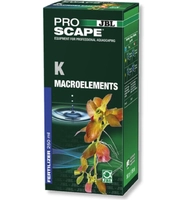



Product Details
- Additional care for plants: supplementary potassium fertiliser for aquascaping aquariums.
- Dosing is dependent on intensity of illumination, Co2 supply and consumption.
- Healthy plant growth, prevents potassium deficiency.
- Checking of dosage with JBL potassium test.
- Package contents: 1 bottle ProScape K Macroelements.
- Use for e.g. high power light aquariums with CO2: 6 ml/100 l daily, under weak light conditions without CO2: 4 ml/100 l weekly.
PRODUCT INFORMATION
Underwater gardener:
- Aquascaping is the term used to describe the technique of designing aquarium landscapes.
- This is the place for plant compositions, for the reproduction of a landscape above water or for natural biotopes.
- An aquascaping aquarium contains no or few fish and invertebrates. This way the nutrient supply for plants is reduced and their growth is limited. Nitrogens, phosphorus and other minerals become scarce substances and need precise re-dosing.
- The plants need light for their healthy growth in a beautiful underwater landscape, CO2 and the right nutrients.
- Please use the dosing calculator at www.proscape.de, to determine the exact fertiliser amount by taking into account the initial values of the aquarium water.
FAQ
I would like to fertilise my plants with your product and change over completely. How do I go about doing that?
> Generally, one should never change plant fertilizers abruptly. The fertilizers from different manufacturers have somewhat different compositions in terms of trace elements. This may cause temporary nutrient changes. It is best to change over in 3 steps:
1) Reduction of the old fertilizer by 1/3; replace this with 1/3 of the new fertilizer. Wait approx. 3-4 weeks and observe the reaction of the plants.
2) Reduction of the old fertilizer by 2/3; replace this with 2/3 of the new fertilizer. Wait approx. 3-4 weeks and observe the reaction of the plants.
3) Complete discontinuation of the old fertilizer and change-over to the new fertilizer.
It is important to observe the reaction of plant growth and, in addition, to check the iron content of the water at least 2x weekly. Whereas the value should never drop to 0, it should never exceed 0.2 mg/l if possible. However, short peaks are no cause for concern.
These measures should generally be carried out on a weekly basis, ideally right after a water change. This achieves better results than fertilizing in large doses at longer intervals.
Where did my algae come from?
> Algae problems in an aquarium can never be traced to just one factor or general condition, and instead, are always the result of a combination of different factors, which include light, fertilization, water changes – specifically, how often and how much – feeding, fish population and, of course, the specific water parameters.
According to analyses that were performed over a course of a number of years, red algae, at least the common brush algae and beard algae, occur in descending order at the following parameters:
1) too little carbon dioxide (in relationship to 100 % of the measured tank); the pH level should be in the slightly acetic range, depending on the carbonate hardness, in every case.
2) elevated phosphate levels (over 90 %); phosphate limitation by means of JBL PhosEx ultra is often helpful here.
3) too little and too irregular fertilization (there should always be traces of iron at least).
4) insufficient water changes; a weekly water change of over 30 % is recommended for algae problems.
5) not enough fast-growing plants.
Should the amount of fertiliser be reduced when there is algae trouble ?
> A comprehensive answer to this question cannot be provided, as this would require a comprehensive analysis of the water, the fertilisation, lighting and the carbon dioxide supply, plus regular water care.
Although algae can be attributed to an excess of nutrients - particularly phosphate and nitrate in this case, - in many cases, they are also the result of a lack of so-called micronutrients, of which iron is the best known. Very often, this is the deeper cause of the algae problem.
When algae growth occurs, it is generally highly advisable to increase the amount and frequency of water changes, make sure there is a sufficient supply of fast-growing plants and fertilise these with JBL Ferropol or JBL Ferropol 24 in accordance with the instructions.
JBL PROSCAPE K
Product Options
Regular
Delivery
 East Ocean Aquatic Havelock
East Ocean Aquatic Havelock Aquarium Fishes, Tanks & Supplies From East Ocean Aquatic Havelock


 SG
SG


